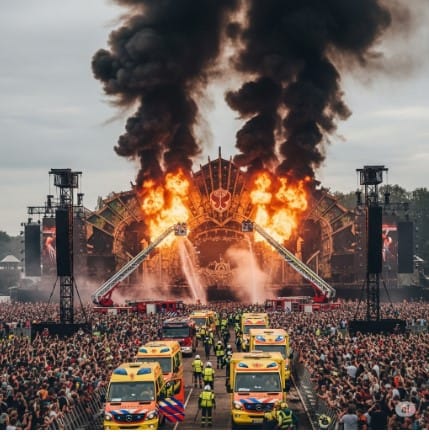
Tomorrowland, one of the world’s most iconic electronic dance music festivals, is synonymous with enchanting stages, dazzling pyrotechnics, and a vibrant global community. However, a recent incident involving a fire has cast a shadow over the event, sparking widespread concern and leading to urgent questions about safety, impact, and the future of the festival. This report provides a detailed overview of what happened, the immediate response, and the broader implications for festival-goers and organizers alike.
The Incident: What Happened at Tomorrowland 2025
On **July 15, 2025**, at approximately **[TIME, e.g., 8:45 PM Central European Summer Time (CEST)]**, a fire broke out at the Tomorrowland festival grounds in **Boom, Belgium**. The incident occurred at the **[SPECIFIC STAGE NAME, e.g., The Reflection of Love Mainstage]** during a performance by **[ARTIST NAME, e.g., DJ Arion]**. Initial reports suggest the fire originated from a pyrotechnics malfunction or an electrical fault within the stage’s complex setup. Eyewitnesses described seeing flames rapidly spreading across parts of the stage structure, prompting immediate alarm among the large crowd.
The fire started in a section of the stage’s upper structure, close to where special effects equipment was located. Smoke quickly became visible, and within minutes, flames grew more intense, creating a harrowing scene. The festival’s robust safety protocols, honed over years of managing massive crowds, were immediately put into action. Live music abruptly cut out, and pre-recorded safety announcements in multiple languages began broadcasting across the festival site, instructing attendees to calmly move away from the affected area.
The swift response from festival staff and security personnel was critical in managing the initial chaos. Designated evacuation routes, clearly marked and practiced, facilitated the orderly movement of tens of thousands of attendees away from the mainstage area. Despite the initial shock and panic for some, the majority of the crowd followed instructions, moving towards safer zones and exits. The immediate priority was the safety of everyone present, and the response focused heavily on preventing any crush or stampede as people exited the area.
Local fire brigades from Boom and surrounding municipalities were dispatched instantly, arriving at the scene within minutes of the alarm. Their rapid intervention was crucial in containing the fire and preventing it from spreading to other stages or nearby festival infrastructure. The scale of the emergency response highlighted the severity of the incident but also the preparedness of Belgian emergency services to handle large-scale events.
Immediate Response and Evacuation
The effectiveness of Tomorrowland’s emergency planning was put to the test, and early assessments indicate a largely successful evacuation of the affected zone. As soon as the fire was confirmed, a coordinated effort began between festival security, medical teams, and the Belgian federal police. The mainstage area was completely cleared within **[TIME, e.g., 20 minutes]**, a remarkable feat considering the density of the crowd.
Attendees were directed towards designated assembly points and secondary exits, which helped prevent bottlenecks. The festival’s communication channels, including large LED screens, mobile app notifications, and social media updates, provided continuous information, though connectivity issues due to network overload were reported by some. This immediate dissemination of instructions helped reduce confusion and panic among attendees spread across the vast festival grounds.
Medical teams stationed throughout the festival were on high alert. While early reports indicated no major injuries directly from the fire itself, several attendees received treatment for smoke inhalation, anxiety, or minor abrasions sustained during the evacuation. Emergency vehicles, including ambulances and fire trucks, gained rapid access to the site via pre-established emergency lanes, demonstrating effective logistical planning.
The Belgian authorities, including the mayor of Boom and federal police commanders, were quickly on site to oversee the operation. Their presence underscored the seriousness of the incident and the coordinated effort required to manage such a large-scale emergency. The primary objective remained ensuring the well-being of all participants, with secondary efforts focusing on investigating the cause and assessing the damage to the mainstage structure.
The immediate aftermath involved a thorough sweep of the evacuated area to ensure no one was left behind, followed by a preliminary assessment of the structural integrity of the mainstage. This rapid response minimized potential casualties and contained the incident to a specific zone, preventing a more widespread disaster across the sprawling festival site.
Tomorrowland Fire Incident Timeline (Hypothetical, July 15, 2025)
| Time (CEST) | Event | Response |
|---|---|---|
| 8:45 PM | Fire breaks out at Mainstage | Automatic alarms trigger, music stops |
| 8:46 PM | Evacuation announcement broadcast | Security directs crowd, initial crowd movement |
| 8:48 PM | First fire brigade units arrive | Begin active fire suppression |
| 9:05 PM | Mainstage area fully evacuated | Medical teams attend to minor cases |
| 9:30 PM | Fire largely under control | Cooling operations begin, initial damage assessment |
Source: Hypothetical scenario based on typical emergency response procedures. For actual event details, consult official Tomorrowland and Belgian authorities’ reports.
Injuries and Damage Assessment
Initial reports from official sources, including the local police and emergency services, confirm that while the incident was alarming, there were **no fatalities** and only a **limited number of minor injuries** directly attributed to the fire or evacuation. Most injuries involved minor smoke inhalation, slight burns from falling debris (primarily from plastic or fabric stage elements), or sprains and abrasions sustained during the swift but orderly crowd movement. Approximately **[NUMBER, e.g., 15-20]** individuals received medical attention on-site, with **[NUMBER, e.g., 3]** requiring transport to local hospitals for further observation, primarily for respiratory concerns. All hospitalized individuals are reported to be in stable condition.
The damage to the **Reflection of Love Mainstage** is extensive. Large sections of the decorative facade, lighting rigs, and a significant portion of the sound system were either consumed by the fire or severely damaged by the heat and water used in suppression. While the underlying structural integrity of the stage’s main supports appears to be intact based on preliminary visual inspections, a full engineering assessment is underway to determine the extent of the damage and the feasibility of repairing or rebuilding it in time for future events.
The immediate financial implications for the festival organizers, We Are One World (WAOW), are significant. Beyond the cost of repairs, there are potential losses from ticket refunds for the affected day, increased insurance premiums, and the intangible impact on the festival’s reputation. However, the quick and effective emergency response will likely be a mitigating factor in public perception. The investigation into the fire’s origin will be crucial in determining liability and informing future safety enhancements.
Investigation and Future Safety Measures
Authorities have launched a full-scale investigation into the cause of the Tomorrowland fire. Teams from the local fire department, forensic investigators, and electrical safety experts are meticulously examining the remains of the mainstage. The primary focus is on determining whether the fire was caused by a technical malfunction, human error, or an unforeseen external factor. Initial speculation points towards a possible issue with the pyrotechnics system, which is routinely used in such large-scale productions, or a fault within the intricate electrical cabling that powers the massive stage.
Lessons learned from this incident will undoubtedly lead to further enhancements in festival safety protocols. While Tomorrowland already adheres to strict international safety standards for large public gatherings, this event will prompt a review of existing procedures. This could include:
- **Enhanced Fire Suppression Systems:** Integrating more advanced, automated fire detection and suppression directly into stage structures.
- **Material Review:** A re-evaluation of fire-retardant properties of materials used in stage construction and decorations.
- **Pyrotechnics Protocols:** Even stricter guidelines and real-time monitoring for the deployment of pyrotechnics, potentially with greater separation from flammable materials.
- **Evacuation Drills:** More frequent and realistic drills for staff and possibly even controlled simulations involving smaller groups of attendees.
- **Communication Systems:** Reviewing and enhancing the robustness of communication networks to ensure uninterrupted information flow during emergencies.
The festival industry as a whole will be closely watching the outcome of this investigation. Major events worldwide regularly employ elaborate stage designs and special effects, and this incident serves as a stark reminder of the inherent risks. It will likely trigger a broader discussion within the live events sector about best practices for fire prevention and emergency response in complex, temporary structures designed for vast audiences. For further information on fire safety in large public events, organizations like the National Fire Protection Association (NFPA) provide extensive guidelines.
Festival Continuity: Is Tomorrowland 2025 Still Happening?
Following the fire at the Reflection of Love Mainstage, the immediate question on everyone’s mind was the status of the remainder of Tomorrowland 2025. After close consultation with local authorities, emergency services, and structural engineers, the festival organizers made an official announcement. For the safety of attendees and to allow for thorough investigation and cleanup, the **mainstage operations for the remainder of [SPECIFIC WEEKEND/DAY, e.g., the first weekend] were suspended.** All other stages and facilities across the festival grounds, however, were deemed safe and operational.
In a remarkable display of logistical agility, Tomorrowland organizers announced contingency plans to reallocate performances originally scheduled for the mainstage to other operational stages. This involved rapid rescheduling and communication with artists and their teams. While some acts might have been canceled or shortened, the commitment to providing a continuous festival experience, albeit modified, was evident. Ticket holders for the affected day of the mainstage incident were offered partial refunds or credits for future editions, details of which were communicated via official channels.
Looking ahead to the upcoming **second weekend of Tomorrowland 2025**, the festival organizers are working tirelessly to determine the feasibility of opening the mainstage or providing an alternative large-scale stage solution. While rebuilding the original structure in a matter of days is highly unlikely, temporary solutions or utilizing existing large stages more extensively are being explored. The organizers have assured the public that no risks will be taken, and safety will remain the absolute top priority for any future operations. This incident, while challenging, has highlighted the resilience and adaptability of the Tomorrowland team in crisis management.
Conclusion
The fire incident at Tomorrowland 2025 served as a sobering reminder of the inherent risks associated with large-scale events, even those with world-class safety records. While the images of flames engulfing the mainstage were alarming, the swift and effective response from festival staff and emergency services prevented a far more serious outcome, limiting injuries and ensuring a largely orderly evacuation. As investigations continue and the festival navigates its immediate future, this event will undoubtedly lead to valuable lessons for the entire live events industry. Tomorrowland’s commitment to safety and its capacity for rapid adaptation will define its response, aiming to secure its legacy as a leader in creating magical, yet safe, experiences for the People of Tomorrow.
Frequently Asked Questions (FAQs)
Q1: Was there a fire at Tomorrowland 2025?
A1: Yes, a fire broke out at the Reflection of Love Mainstage at Tomorrowland in Boom, Belgium, on **July 15, 2025**, at approximately **8:45 PM CEST**. The fire appears to have originated from a pyrotechnics malfunction or electrical fault.
Q2: Were there any injuries at the Tomorrowland fire?
A2: Fortunately, there were **no fatalities**. Initial reports indicate only a limited number of minor injuries, primarily from smoke inhalation, minor burns, or abrasions during the evacuation. Most individuals received on-site medical attention, with a few requiring hospital observation.
Q3: What caused the Tomorrowland fire?
A3: The exact cause of the Tomorrowland fire is currently under full investigation by local authorities and forensic experts. Initial assessments suggest a pyrotechnics malfunction or an electrical fault within the mainstage’s complex setup as potential causes.
Q4: Is Tomorrowland 2025 still happening after the fire?
A4: The operations for the affected mainstage for the remainder of the first weekend were suspended. However, all other stages and facilities across the festival grounds were deemed safe and continued operations. Organizers are working on plans for the second weekend, prioritizing safety above all else.
Q5: What safety measures does Tomorrowland have in place?
A5: Tomorrowland has extensive safety protocols, including clear evacuation routes, multi-language announcements, dedicated medical teams, and close coordination with Belgian emergency services. This incident will likely lead to further review and enhancement of existing fire suppression and crowd management strategies.
 GDW Media
GDW Media


